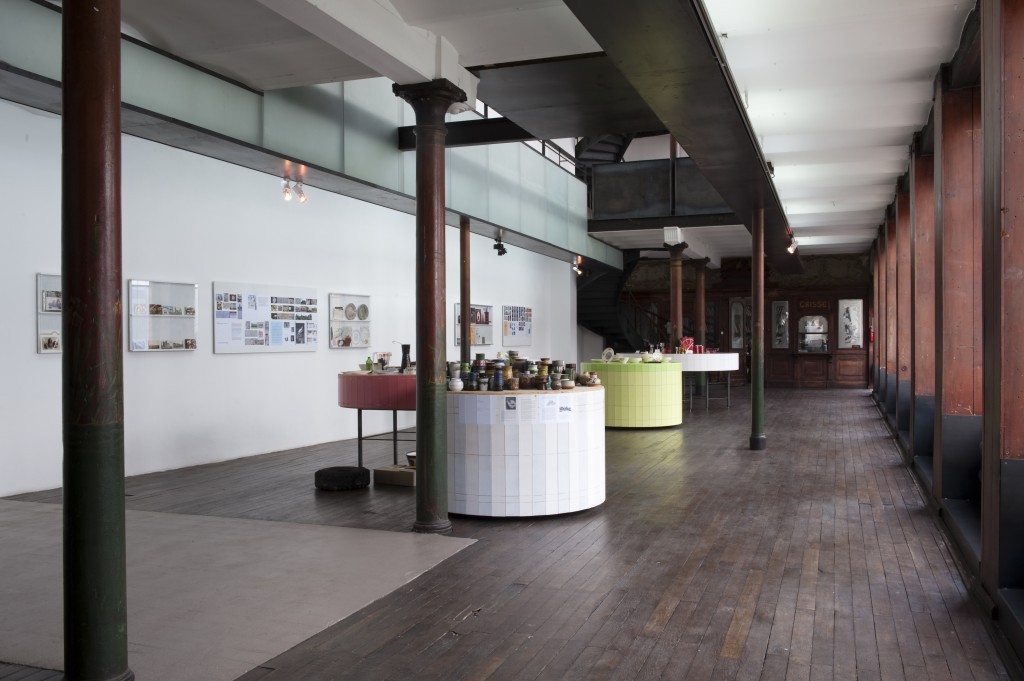Manfred Pernice
20 Jun - 03 Oct 2010
MANFRED PERNICE
liquidation-tischwelten2
20 June - 3 October 2010
When engaging with a particular territory, one is likely to come across information from various realms of activity. The geographical, historic, economic or cultural data thus collected eventually aggregates into a subjectively biased image of a given place at a given time. The main characteristic and quality of Manfred Pernice’s work is its acknowledgement of the simultaneousness of facts and their brittle or soft margins, which it shapes and arranges into a sequence. The entanglement – or ‘mash’ (liquidation), as he likes to call it – that blends together the artist’s life experiences (knowledge, things seen and collected) and the invitations or encounters that are likely to expand the frame of reference and result in an exhibition based on new motifs, forms an intrinsic part of his artistic practice. Related or unexpected things are ordered so as to offer a heterogeneous outlook and overview, which can also be read as a realistic look cast on ‘something’.
Combining crystal and ceramic items with miscellanea and found objects laid out on display tables, the setting of liquidation-tischwelten2 is vaguely reminiscent of a department store. Everything must go!
Around 1900 the building in Strasbourg which now hosts the Ceaac (Centre européen d’actions artistiques) housed ‘the largest glass and porcelain outlet in Alsace-Lorraine’.1A large number of glass, ceramic and porcelain manufactories had established in Alsace and the greater region2 from the 19th century onwards. Whether a table service from Badonviller, which was smuggled across the border to the Saarland in the 1950s, the latest range of Baccarat crystal ware or a reissue of ceramic bowls from the former Lunéville manufactory, their products bear testimony to the cultural and political developments of the region.
Manfred Pernice’s installations often comprise recipients of various provenance. The way in which these are displayed (and thus either highlighted or downplayed) is as significant as their origin: although ceramic products from Strehla on the Elbe3had a stable market share in the GDR, production had to be abandoned in 1997, when it appeared that even manufacturing affordable faience tableware would no longer be profitable. The table with porcelain from Kahla in Thuringia4 evidences a wider interest in the history of the everyday, whose intention to assign a local or supra-regional occurrence to each of the pieces has resulted in an incipient presentation of a ramification or a narrative structure. By so doing, it reflects on the daily use of porcelain and ceramic as recipients which are commonly believed to have an essential connection to ‘real’ life and are therefore prone to be filled again with history(ies).
1) From a newspaper advertisement for Neunreiter & Son, Purveyors to the Court, Strasbourg, ca. 1900.
2) The greater region comprises Lorraine, Luxembourg, Wallonia, Rhineland-Palatinate and Saarland.
3) Cf. ill. Bankomat.
4) Shown in the exhibition AVA 1. Allgemeine Verkstattausstellung in Berlin’s Schinkel Pavilion, 2008.
liquidation-tischwelten2
20 June - 3 October 2010
When engaging with a particular territory, one is likely to come across information from various realms of activity. The geographical, historic, economic or cultural data thus collected eventually aggregates into a subjectively biased image of a given place at a given time. The main characteristic and quality of Manfred Pernice’s work is its acknowledgement of the simultaneousness of facts and their brittle or soft margins, which it shapes and arranges into a sequence. The entanglement – or ‘mash’ (liquidation), as he likes to call it – that blends together the artist’s life experiences (knowledge, things seen and collected) and the invitations or encounters that are likely to expand the frame of reference and result in an exhibition based on new motifs, forms an intrinsic part of his artistic practice. Related or unexpected things are ordered so as to offer a heterogeneous outlook and overview, which can also be read as a realistic look cast on ‘something’.
Combining crystal and ceramic items with miscellanea and found objects laid out on display tables, the setting of liquidation-tischwelten2 is vaguely reminiscent of a department store. Everything must go!
Around 1900 the building in Strasbourg which now hosts the Ceaac (Centre européen d’actions artistiques) housed ‘the largest glass and porcelain outlet in Alsace-Lorraine’.1A large number of glass, ceramic and porcelain manufactories had established in Alsace and the greater region2 from the 19th century onwards. Whether a table service from Badonviller, which was smuggled across the border to the Saarland in the 1950s, the latest range of Baccarat crystal ware or a reissue of ceramic bowls from the former Lunéville manufactory, their products bear testimony to the cultural and political developments of the region.
Manfred Pernice’s installations often comprise recipients of various provenance. The way in which these are displayed (and thus either highlighted or downplayed) is as significant as their origin: although ceramic products from Strehla on the Elbe3had a stable market share in the GDR, production had to be abandoned in 1997, when it appeared that even manufacturing affordable faience tableware would no longer be profitable. The table with porcelain from Kahla in Thuringia4 evidences a wider interest in the history of the everyday, whose intention to assign a local or supra-regional occurrence to each of the pieces has resulted in an incipient presentation of a ramification or a narrative structure. By so doing, it reflects on the daily use of porcelain and ceramic as recipients which are commonly believed to have an essential connection to ‘real’ life and are therefore prone to be filled again with history(ies).
1) From a newspaper advertisement for Neunreiter & Son, Purveyors to the Court, Strasbourg, ca. 1900.
2) The greater region comprises Lorraine, Luxembourg, Wallonia, Rhineland-Palatinate and Saarland.
3) Cf. ill. Bankomat.
4) Shown in the exhibition AVA 1. Allgemeine Verkstattausstellung in Berlin’s Schinkel Pavilion, 2008.

